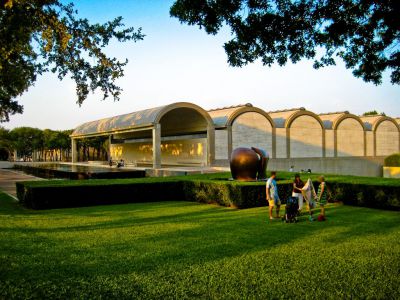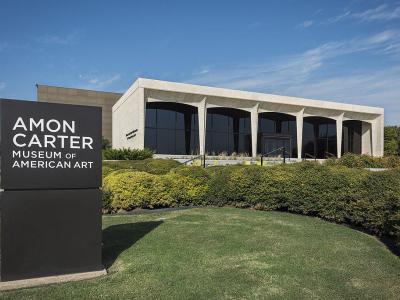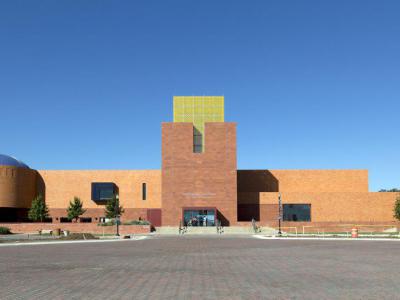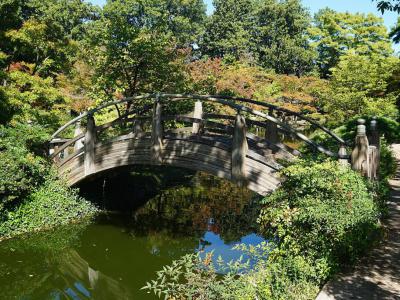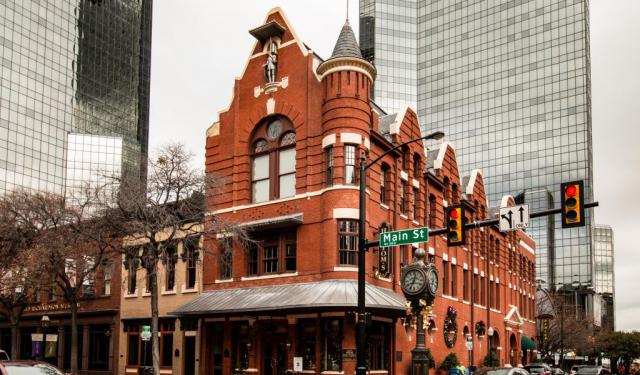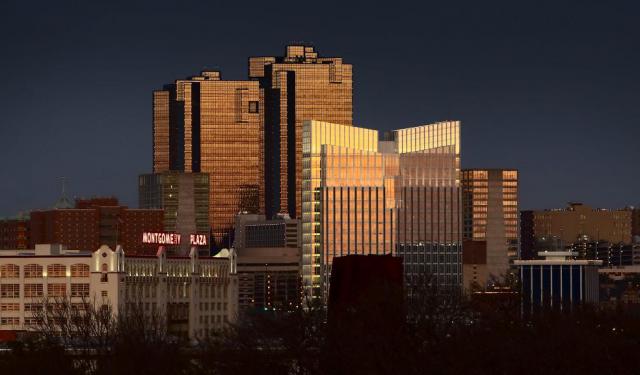
Cultural District Walking Tour (Self Guided), Fort Worth
Just minutes away from the hustle and bustle of the downtown's daily commerce, the Fort Worth Cultural District is a true gem deep in the heart of the city. Bordered by a tree lined boulevard paved with bricks and surrounded by manicured grounds, the area is alive with charming shops and restaurants.
But most importantly, the district is a home to the five prominent museums, such as the architecturally striking Modern Art Museum of Fort Worth; the Kimbell Art Museum – boasting a wealth of European paintings and priceless antiquities; the Fort Worth Museum of Science and History; the Amon Carter Museum; and the National Cowgirl Museum and Hall of Fame – honoring the courageous women of the American West whose pioneer spirit was instrumental in their trail blazing efforts.
The abundance of the world-class collections of artworks from America and around the world, spanning virtually the entire history of art, as well as exotic science and cultural exhibits, have earned the area the title of the "museum capital of the Southwest".
Alongside these diverse collections, you will also find in the Cultural District acclaimed theaters with exciting performances and the much loved by so many Will Rogers Memorial Center – a place of the Annual Fort Worth Stock Show, rodeos, and other events.
Those in favor of natural masterpieces will undoubtedly enjoy the Fort Worth Botanic Gardens with its Japanese Garden section and other floral delights.
Since all of these celebrated attractions are within walking distance, you can easily explore them on foot. To find inspiration, broaden your horizons and spend quality time in a beautiful, park-like setting, take this self-guided walk and enjoy the rich heritage of Fort Worth's wonderful Cultural District.
But most importantly, the district is a home to the five prominent museums, such as the architecturally striking Modern Art Museum of Fort Worth; the Kimbell Art Museum – boasting a wealth of European paintings and priceless antiquities; the Fort Worth Museum of Science and History; the Amon Carter Museum; and the National Cowgirl Museum and Hall of Fame – honoring the courageous women of the American West whose pioneer spirit was instrumental in their trail blazing efforts.
The abundance of the world-class collections of artworks from America and around the world, spanning virtually the entire history of art, as well as exotic science and cultural exhibits, have earned the area the title of the "museum capital of the Southwest".
Alongside these diverse collections, you will also find in the Cultural District acclaimed theaters with exciting performances and the much loved by so many Will Rogers Memorial Center – a place of the Annual Fort Worth Stock Show, rodeos, and other events.
Those in favor of natural masterpieces will undoubtedly enjoy the Fort Worth Botanic Gardens with its Japanese Garden section and other floral delights.
Since all of these celebrated attractions are within walking distance, you can easily explore them on foot. To find inspiration, broaden your horizons and spend quality time in a beautiful, park-like setting, take this self-guided walk and enjoy the rich heritage of Fort Worth's wonderful Cultural District.
How it works: Download the app "GPSmyCity: Walks in 1K+ Cities" from Apple App Store or Google Play Store to your mobile phone or tablet. The app turns your mobile device into a personal tour guide and its built-in GPS navigation functions guide you from one tour stop to next. The app works offline, so no data plan is needed when traveling abroad.
Cultural District Walking Tour Map
Guide Name: Cultural District Walking Tour
Guide Location: USA » Fort Worth (See other walking tours in Fort Worth)
Guide Type: Self-guided Walking Tour (Sightseeing)
# of Attractions: 8
Tour Duration: 2 Hour(s)
Travel Distance: 3.5 Km or 2.2 Miles
Author: ChristineR
Sight(s) Featured in This Guide:
Guide Location: USA » Fort Worth (See other walking tours in Fort Worth)
Guide Type: Self-guided Walking Tour (Sightseeing)
# of Attractions: 8
Tour Duration: 2 Hour(s)
Travel Distance: 3.5 Km or 2.2 Miles
Author: ChristineR
Sight(s) Featured in This Guide:
- Modern Art Museum of Fort Worth
- Kimbell Art Museum
- Amon Carter Museum of American Art
- Will Rogers Memorial Center
- Fort Worth Museum of Science and History
- National Cowgirl Museum & Hall of Fame
- Fort Worth Botanic Garden
- Fort Worth Japanese Garden
1) Modern Art Museum of Fort Worth
The Modern Art Museum of Fort Worth was first granted a Charter from the State of Texas in 1892 as the "Fort Worth Public Library and Art Gallery", evolving through several name changes and different facilities in Fort Worth. The mission of the museum is "collecting, presenting and interpreting international developments in post-World War II art in all media."
The current building, designed by Japanese architect Tadao Ando was opened to the public on Saturday, December 14, 2002. The "Modern" is located in the city's Cultural District, adjacent to the Kimbell Art Museum, designed by Louis I. Kahn, and near the Amon Carter Museum, designed by Philip Johnson. The building features five long, pavilions set into a reflecting pond. The structural engineering was provided by Thornton Tomasetti.
The Museum currently contains over 2,600 works of art in its 53,000 square feet (4,900 m2) of gallery space, putting it at the forefront of post World War II art collections in the central United States. The Permanent Collection includes more than 3,000 works including pieces by Pablo Picasso, Anselm Kiefer, Robert Motherwell, Susan Rothenberg, Jackson Pollock, Gerhard Richter, Richard Serra, Andres Serrano, Cindy Sherman, and Andy Warhol.
The current building, designed by Japanese architect Tadao Ando was opened to the public on Saturday, December 14, 2002. The "Modern" is located in the city's Cultural District, adjacent to the Kimbell Art Museum, designed by Louis I. Kahn, and near the Amon Carter Museum, designed by Philip Johnson. The building features five long, pavilions set into a reflecting pond. The structural engineering was provided by Thornton Tomasetti.
The Museum currently contains over 2,600 works of art in its 53,000 square feet (4,900 m2) of gallery space, putting it at the forefront of post World War II art collections in the central United States. The Permanent Collection includes more than 3,000 works including pieces by Pablo Picasso, Anselm Kiefer, Robert Motherwell, Susan Rothenberg, Jackson Pollock, Gerhard Richter, Richard Serra, Andres Serrano, Cindy Sherman, and Andy Warhol.
Sight description based on Wikipedia.
2) Kimbell Art Museum (must see)
The Kimbell Art Museum in Fort Worth, hosts a small but excellent art collection as well as traveling art exhibitions, educational programs and an extensive research library. Its initial artwork came from the private collection of Kay and Velma Kimbell, who also provided funds for a new building to house it.
The building was designed by renowned architect Louis I. Kahn and is widely recognized as one of the most significant works of architecture of recent times. It is especially noted for the wash of silvery natural light across its vaulted gallery ceilings.
The European collection is the most extensive in the museum and includes Michelangelo's first known painting, The Torment of Saint Anthony, the only painting by Michelangelo on exhibit in the Americas.
The museum also houses a substantial library with over 59,000 books, periodicals and auction catalogs that are available as a resource to art historians and to faculty and graduate students from surrounding universities.
The building was designed by renowned architect Louis I. Kahn and is widely recognized as one of the most significant works of architecture of recent times. It is especially noted for the wash of silvery natural light across its vaulted gallery ceilings.
The European collection is the most extensive in the museum and includes Michelangelo's first known painting, The Torment of Saint Anthony, the only painting by Michelangelo on exhibit in the Americas.
The museum also houses a substantial library with over 59,000 books, periodicals and auction catalogs that are available as a resource to art historians and to faculty and graduate students from surrounding universities.
Sight description based on Wikipedia.
3) Amon Carter Museum of American Art (must see)
The Amon Carter Museum of American Art is located in Fort Worth. It was established by Amon G. Carter to house his collection of paintings and sculpture by Frederic Remington and Charles M. Russell. Carter’s will provided a museum in Fort Worth devoted to American art.
When the museum opened in 1961, its first director, Mitchell A. Wilder, sought a broader vision for its collection. Wilder believed that the grand story of American art could be interpreted as the history of many artists at different times working on “successive frontiers” in the great pageant of American history. As a result of this vision, the museum's collections began to expand in many fascinating ways, from the first landscape painters of the 1830s to modern artists of the twentieth century.
Today, the collection includes masterworks by such artists as Alexander Calder, Thomas Cole, Stuart Davis, Thomas Eakins, Winslow Homer, Georgia O'Keeffe, John Singer Sargent, Charles Demuth, Martin Johnson Heade and Alfred Stieglitz. The museum also possesses one of the premier collections of American photography in the nation, comprising more than 30,000 exhibition prints by some 400 photographers. The photography collection also includes the work and archives of several notable American photographers, including Laura Gilpin, Eliot Porter, and Karl Struss. The museum continues to collect American art and produce related programs, publications, and exhibitions. Philip Johnson, the museum’s original architect, designed and completed the building’s most recent expansion in 2001.
When the museum opened in 1961, its first director, Mitchell A. Wilder, sought a broader vision for its collection. Wilder believed that the grand story of American art could be interpreted as the history of many artists at different times working on “successive frontiers” in the great pageant of American history. As a result of this vision, the museum's collections began to expand in many fascinating ways, from the first landscape painters of the 1830s to modern artists of the twentieth century.
Today, the collection includes masterworks by such artists as Alexander Calder, Thomas Cole, Stuart Davis, Thomas Eakins, Winslow Homer, Georgia O'Keeffe, John Singer Sargent, Charles Demuth, Martin Johnson Heade and Alfred Stieglitz. The museum also possesses one of the premier collections of American photography in the nation, comprising more than 30,000 exhibition prints by some 400 photographers. The photography collection also includes the work and archives of several notable American photographers, including Laura Gilpin, Eliot Porter, and Karl Struss. The museum continues to collect American art and produce related programs, publications, and exhibitions. Philip Johnson, the museum’s original architect, designed and completed the building’s most recent expansion in 2001.
Sight description based on Wikipedia.
4) Will Rogers Memorial Center
The Will Rogers Memorial Center (WRMC) is an 120-acre (0.49 km2) American public entertainment, sports and livestock complex. It is named for American humorist and writer Will Rogers. It is the home of the annual Fort Worth Stock Show and Rodeo. It is a popular location for the hosting of specialized equestrian and livestock shows, including the annual National Reined Cow Horse Association Snaffle Bit Futurity, World Championship Paint Horse Show, and 3 major events of the National Cutting Horse Association each year. It is also the former home of the Fort Worth Texans ice hockey team, and it hosted a PBR Bud Light Cup Series (later Built Ford Tough Series) annually from 1995 to 2004.
The Memorial Center was built in 1936 and designed by architect Wyatt C. Hedrick, who employed the Moderne (Art Deco) style. Also in 1936 Amon G. Carter commissioned Electra Waggoner Biggs to create the statue Riding into the Sunset, a tribute to Will Rogers and his horse Soapsuds. Over a decade later, in 1947, the work was unveiled at the Center. On March 22, 2016, the complex was placed on the National Register of Historic Places.
The Dickies Arena, which opened in November 2019, is located adjacent to the complex. The new 14,000-seat venue will host the Fort Worth Stock Show rodeos, concerts and early-round games in the 2022 NCAA Men's Division I Basketball Tournament; however, Will Rogers Memorial Coliseum will continue to operate as an equestrian arena in Fort Worth.
The Memorial Center was built in 1936 and designed by architect Wyatt C. Hedrick, who employed the Moderne (Art Deco) style. Also in 1936 Amon G. Carter commissioned Electra Waggoner Biggs to create the statue Riding into the Sunset, a tribute to Will Rogers and his horse Soapsuds. Over a decade later, in 1947, the work was unveiled at the Center. On March 22, 2016, the complex was placed on the National Register of Historic Places.
The Dickies Arena, which opened in November 2019, is located adjacent to the complex. The new 14,000-seat venue will host the Fort Worth Stock Show rodeos, concerts and early-round games in the 2022 NCAA Men's Division I Basketball Tournament; however, Will Rogers Memorial Coliseum will continue to operate as an equestrian arena in Fort Worth.
Sight description based on Wikipedia.
5) Fort Worth Museum of Science and History
The Fort Worth Museum of Science and History is located on 1600 Gendy Street in Fort Worth. It was opened in 1945 as the Fort Worth Children's Museum and moved to its current location in 1954. In 1968, the museum adopted its current name. Attractions at the museum include the Noble Planetarium and the Omni Theater, with a Star's Cafe and A Shop Too! Gift Shop, in addition to both traveling and permanent science and history exhibits.
In the fall of 2007, the museum was closed for renovations. The entire museum was moved into a new building at the same site in 2009. The new building, was designed by architects Legorreta + Legorreta with Gideon Toal and consists of 166,000 square feet. The total maximum occupancy is 3,369 individuals. The museum's grand opening after renovations was on Friday, November 20, 2009.
In the fall of 2007, the museum was closed for renovations. The entire museum was moved into a new building at the same site in 2009. The new building, was designed by architects Legorreta + Legorreta with Gideon Toal and consists of 166,000 square feet. The total maximum occupancy is 3,369 individuals. The museum's grand opening after renovations was on Friday, November 20, 2009.
Sight description based on Wikipedia.
6) National Cowgirl Museum & Hall of Fame
The National Cowgirl Museum and Hall of Fame is a museum and association which honors women of the American West who have displayed courage or spirit and who have distinguished themselves while exemplifying the pioneer spirit. The facility is located in the Cultural District of Fort Worth adjacent to the Fort Worth Museum of Science and History.
The museum was begun in the small basement of the library in Hereford, the seat of Deaf Smith County in West Texas by Margaret Clark Formby (1929–2003), wife of the radio broadcaster Clint Formby. Formby sought for a larger city to take over the exhibits, and Fort Worth won the competition. Formby's husband's uncle was the Texas politician Marshall Formby, a state senator, highway commissioner, and gubernatorial candidate.
The museum was begun in the small basement of the library in Hereford, the seat of Deaf Smith County in West Texas by Margaret Clark Formby (1929–2003), wife of the radio broadcaster Clint Formby. Formby sought for a larger city to take over the exhibits, and Fort Worth won the competition. Formby's husband's uncle was the Texas politician Marshall Formby, a state senator, highway commissioner, and gubernatorial candidate.
Sight description based on Wikipedia.
7) Fort Worth Botanic Garden (must see)
The Fort Worth Botanic Garden is the oldest major botanic garden in Texas. Work began on the botanic garden in 1929 and was completed in 1934. It was designed by the Hare & Hare architectural firm in a Renaissance style.
The botanic garden includes a wide range of garden styles to display the largest possible variety of plant life. The most popular gardens are the Fuller Garden, which is often used for weddings; the Rose Gardens, which have hundreds of rose varieties and the Japanese Garden, which is seven acres of koi ponds, waterfalls, teahouses, pavilions and cherry trees.
The Back Yard Vegetable Garden, as the name suggests, is a vegetable garden that grows many different species. It also hosts educational programs for those who wish to begin urban gardening. The Trial Garden is another educational experience where hundreds of species of perennials are evaluated.
Other gardens include the Conservatory, Four Seasons Garden, Fragrance Garden, Native Texas Boardwalk, Perennial Garden, Rock Springs, Water Conservation Garden and the Water Wise Entrance.
The Fort Worth Botanic Garden is located in the Cultural District near Trinity Park. It is open from 8 AM to 6 PM daily in the summer and 8 AM to 5 PM in the winter.
The botanic garden includes a wide range of garden styles to display the largest possible variety of plant life. The most popular gardens are the Fuller Garden, which is often used for weddings; the Rose Gardens, which have hundreds of rose varieties and the Japanese Garden, which is seven acres of koi ponds, waterfalls, teahouses, pavilions and cherry trees.
The Back Yard Vegetable Garden, as the name suggests, is a vegetable garden that grows many different species. It also hosts educational programs for those who wish to begin urban gardening. The Trial Garden is another educational experience where hundreds of species of perennials are evaluated.
Other gardens include the Conservatory, Four Seasons Garden, Fragrance Garden, Native Texas Boardwalk, Perennial Garden, Rock Springs, Water Conservation Garden and the Water Wise Entrance.
The Fort Worth Botanic Garden is located in the Cultural District near Trinity Park. It is open from 8 AM to 6 PM daily in the summer and 8 AM to 5 PM in the winter.
8) Fort Worth Japanese Garden (must see)
The Fort Worth Japanese Garden in the Fort Worth Botanic Garden was built in 1973. Many of the plants and construction materials for it were donated by Fort Worth's sister city Nagaoka, Japan. Attractions at the garden include a zen garden, a moon viewing (tsukimi) deck, waterfalls, cherry trees, Japanese maples, a pagoda, and fishfood dispensers to feed the hundreds of koi (colored varieties of the Amur carp, kept for decorative purposes) in three ponds.
Built in the tradition of Edo-period (1600-1868) stroll gardens, the Fort Worth Japanese Garden integrates several Japanese styles of garden design into a single landscape. Examples of the 'Hill-and-Pond' (tsukiyama rinsentei), 'Dry Landscape' (karesansui), 'Tea Garden' (roji), and 'Enclosed-Garden' (tsubo niwa) types are all expressed here. In addition, the garden features architectural elements derived from venues historically associated with Japanese gardening. These include Buddhist temples, Imperial villas, the estates of Samurai lords, and the townhouse gardens of wealthy merchants.
Several unconventional architectural elements are also exhibited in the Fort Worth Japanese garden, including the so-called 'Pavilion', a derivative of a Shinto shrine's main hall. It stands above the ground on posts, and features several gabled roofs with criss-crossed extensions (chigi). Another unusual garden element is the 'Mikoshi', an ornate palanquin donated to Fort Worth by the citizens of Nagaoka, Japan. Likewise, a 'taijitu' (yin-yang symbol), a graceful Indochinese Buddha, and three stone monkeys (Mizaru, Kikazaru, and Iwazaru), are all atypical additions unique to this Fort Worth exhibit.
The Fort Worth Japanese Garden is also known for hosting two annual events, such as the Spring Festival and the Fall Festival, featuring demonstrations of Japanese art and culture.
Built in the tradition of Edo-period (1600-1868) stroll gardens, the Fort Worth Japanese Garden integrates several Japanese styles of garden design into a single landscape. Examples of the 'Hill-and-Pond' (tsukiyama rinsentei), 'Dry Landscape' (karesansui), 'Tea Garden' (roji), and 'Enclosed-Garden' (tsubo niwa) types are all expressed here. In addition, the garden features architectural elements derived from venues historically associated with Japanese gardening. These include Buddhist temples, Imperial villas, the estates of Samurai lords, and the townhouse gardens of wealthy merchants.
Several unconventional architectural elements are also exhibited in the Fort Worth Japanese garden, including the so-called 'Pavilion', a derivative of a Shinto shrine's main hall. It stands above the ground on posts, and features several gabled roofs with criss-crossed extensions (chigi). Another unusual garden element is the 'Mikoshi', an ornate palanquin donated to Fort Worth by the citizens of Nagaoka, Japan. Likewise, a 'taijitu' (yin-yang symbol), a graceful Indochinese Buddha, and three stone monkeys (Mizaru, Kikazaru, and Iwazaru), are all atypical additions unique to this Fort Worth exhibit.
The Fort Worth Japanese Garden is also known for hosting two annual events, such as the Spring Festival and the Fall Festival, featuring demonstrations of Japanese art and culture.
Sight description based on Wikipedia.
Walking Tours in Fort Worth, Texas
Create Your Own Walk in Fort Worth
Creating your own self-guided walk in Fort Worth is easy and fun. Choose the city attractions that you want to see and a walk route map will be created just for you. You can even set your hotel as the start point of the walk.
Fort Worth Historical Buildings
Among the many ways to explore the richness of heritage fabric in Fort Worth there is one by historical architecture. Back in the 1920s-30s, the majority of Fort Worth’s notable buildings were designed by either Sanguinet & Staats or Wyatt Hedrick.
The former, in particular, were responsible for creating, among other structures, the Flatiron – one of the first high-risers in Fort Worth.... view more
Tour Duration: 2 Hour(s)
Travel Distance: 3.5 Km or 2.2 Miles
The former, in particular, were responsible for creating, among other structures, the Flatiron – one of the first high-risers in Fort Worth.... view more
Tour Duration: 2 Hour(s)
Travel Distance: 3.5 Km or 2.2 Miles
Stockyards Cowtown Walking Tour
Once a major livestock center and a home to cowboys, cattlemen and outlaws, Fort Worth, TX has fully lived up to its nickname – “Cowtown.” From the late 1870s through the mid 1980s, the Fort Worth Stockyards made the city famous, drawing cattle from all over the state. Today mainly inactive, the Stockyards – "the last standing stockyards in the United States" – celebrates Fort... view more
Tour Duration: 1 Hour(s)
Travel Distance: 0.8 Km or 0.5 Miles
Tour Duration: 1 Hour(s)
Travel Distance: 0.8 Km or 0.5 Miles
Fort Worth Introduction Walk
At over 900,000 people in the city proper and more than 7 million in the metro area, Fort Worth is one of the largest cities in the country. This now booming metropolis had a surprisingly meager start less than 200 years ago.
The history of Fort Worth began in 1849 with the establishment of a fort to protect the frontier after the Mexican-American War. Fort Worth was just one fortification in a... view more
Tour Duration: 1 Hour(s)
Travel Distance: 1.5 Km or 0.9 Miles
The history of Fort Worth began in 1849 with the establishment of a fort to protect the frontier after the Mexican-American War. Fort Worth was just one fortification in a... view more
Tour Duration: 1 Hour(s)
Travel Distance: 1.5 Km or 0.9 Miles
The Most Popular Cities
/ view all

